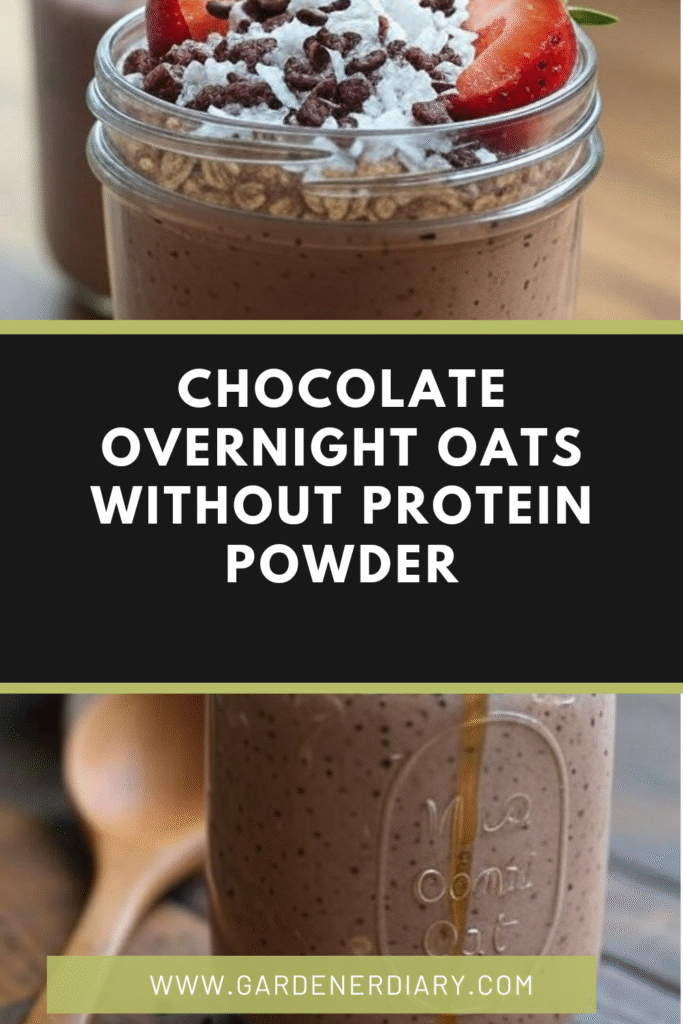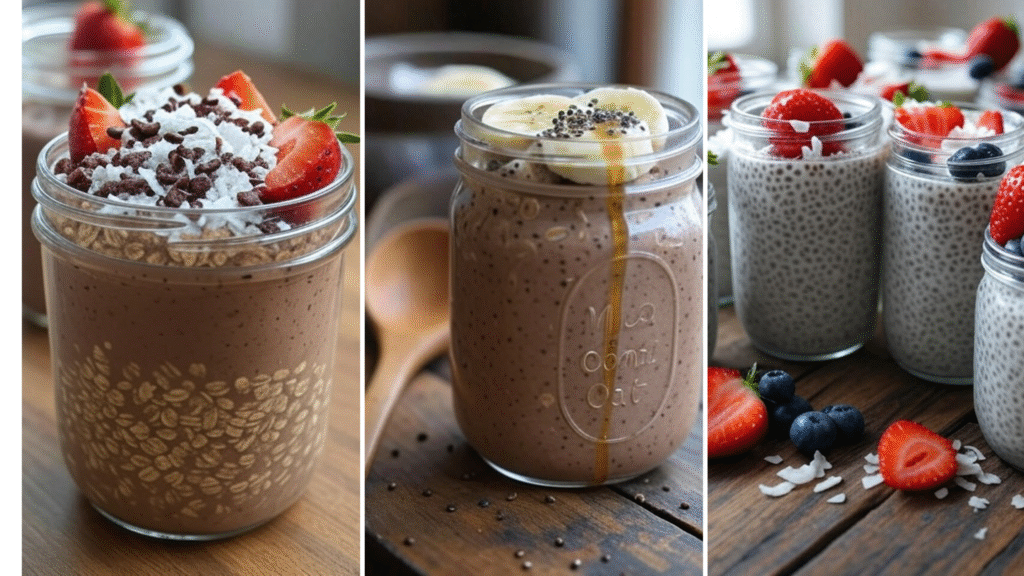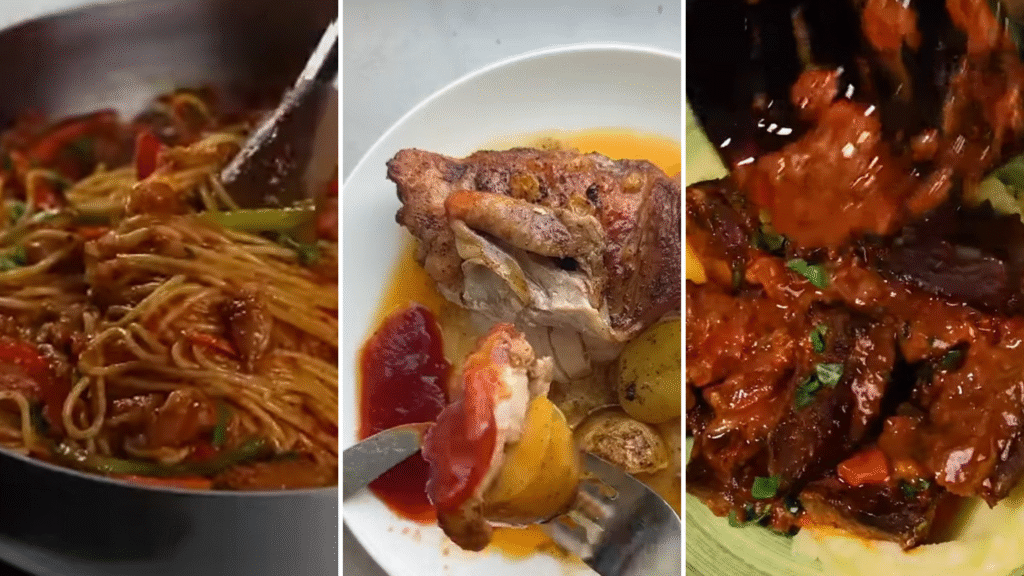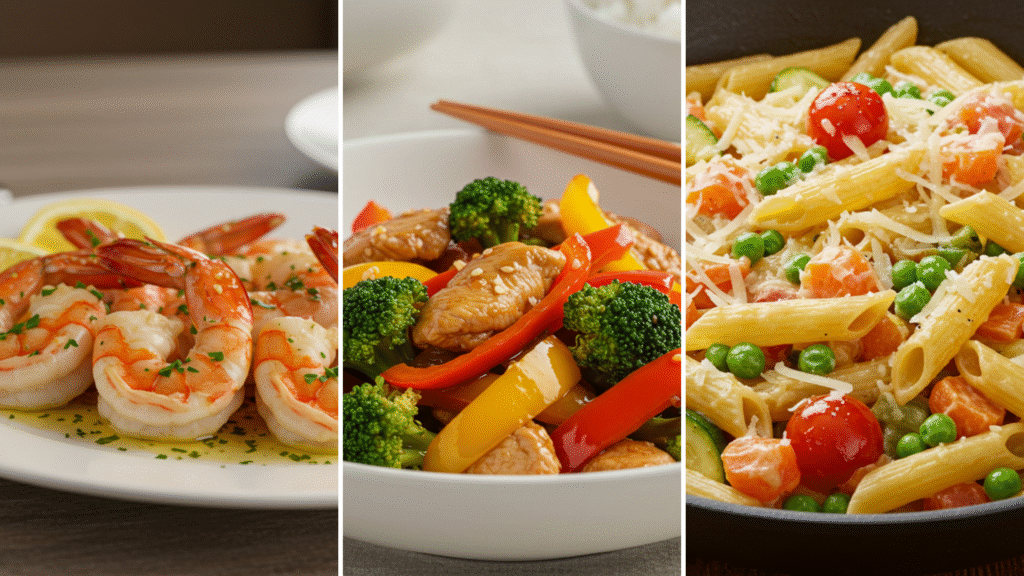Chocolate overnight oats are a simple, filling, and tasty breakfast option. You prepare them the night before and wake up to a ready-made meal. Many recipes use protein powder, but you can enjoy a creamy, chocolate-rich bowl without it. This post will show you how to make chocolate overnight oats without protein powder and why they are a great choice for busy mornings.
Key Takeaway:
- Chocolate overnight oats can be made without protein powder using simple whole foods.
- Rolled oats, cocoa powder, chia seeds, milk, and natural sweeteners form the base.
- Benefits include easier digestion, richer cocoa flavor, and lower cost compared to protein powders.
- Variations include banana, peanut butter, mocha, or berry chocolate oats.
- Nutrition comes from oats (fiber), cocoa (antioxidants), chia seeds (protein and omega-3), and milk or yogurt (calcium and protein).
- Tips: use rolled oats, balance cocoa with sweetness, and add toppings right before serving.
- Common mistakes include too little liquid, using instant oats, or skipping sweetener.
- They last up to 4 days in the fridge and can be made vegan with plant-based milk/yogurt.
- Ideal for meal prep and quick, nutritious breakfasts.
Quick Comparison: With vs. Without Protein Powder
| Feature | With Protein Powder | Without Protein Powder |
|---|---|---|
| Texture | Thicker and dense | Creamy and smooth |
| Protein Source | Powder supplement | Natural foods (chia seeds, nuts, milk, yogurt) |
| Flavor | Strong protein taste | Pure cocoa and oats taste |
| Digestibility | May cause bloating | Easier to digest |
| Customization | Limited by powder flavor | More freedom with natural ingredients |
Why Choose Chocolate Overnight Oats Without Protein Powder?
- Natural ingredients: You use whole foods like oats, milk, and cocoa powder.
- Better digestion: Many people experience bloating from protein powders. Skipping it can help.
- Rich flavor: Pure cocoa creates a deep chocolate taste.
- Affordable: No need to spend extra money on protein supplements.
If you prefer protein-rich breakfasts without powders, you can also check this guide on high-protein vegan breakfast without protein powder.
Ingredients You Need
Here is a simple list of ingredients:
- Rolled oats (½ cup)
- Cocoa powder (1–2 tablespoons)
- Chia seeds (1 tablespoon)
- Sweetener of choice (maple syrup, honey, or stevia)
- Milk of choice (dairy, almond, soy, or oat milk)
- Greek yogurt (optional for creaminess)
- Toppings: banana, strawberries, crushed nuts, or shredded coconut
Step-by-Step Recipe
- Combine dry ingredients: Mix rolled oats, cocoa powder, and chia seeds in a jar or bowl.
- Add liquid: Pour in milk and stir well. Add Greek yogurt if using.
- Sweeten: Add maple syrup or your preferred sweetener.
- Refrigerate: Cover and let sit overnight, or for at least 6 hours.
- Serve: Stir the mixture, then top with fruits, nuts, or coconut before eating.
Flavor Variations
Chocolate overnight oats can be customized in many ways. Here are some ideas:
- Chocolate banana oats: Add mashed banana before refrigeration.
- Chocolate peanut butter oats: Swirl in a spoon of peanut butter. If you want more ideas, see overnight oats with chocolate protein powder and peanut butter.
- Mocha oats: Mix in a teaspoon of instant coffee with cocoa.
- Berry chocolate oats: Add strawberries, raspberries, or blueberries.
Nutrition Benefits
Chocolate overnight oats without protein powder still offer a nutritious breakfast:
- Oats: Provide fiber for better digestion.
- Cocoa: Contains antioxidants for heart health.
- Chia seeds: Add protein, fiber, and omega-3 fats.
- Milk or yogurt: Supplies calcium and extra protein.
- Fruits: Give vitamins and natural sweetness.
For more balanced breakfast inspiration, read about high-protein low-carb vegan breakfast.
Tips for Perfect Overnight Oats
- Use rolled oats instead of instant oats for better texture.
- Add a little extra milk if the oats feel too thick in the morning.
- Use unsweetened cocoa powder for a deep chocolate taste.
- Prepare multiple jars at once for meal prep.
- Mix toppings just before serving for freshness.
Common Mistakes to Avoid
- Not enough liquid: This can make oats dry and clumpy.
- Skipping sweetener: Cocoa alone can taste bitter. Balance it with fruit or syrup.
- Using quick oats: They can turn mushy.
- Overloading with toppings: Too many extras can add unnecessary calories.
Chocolate Overnight Oats vs. Chocolate Protein Oats
Some people prefer protein-based versions. You can check chocolate protein overnight oats with chia seeds for comparison. But if you want something lighter and fully natural, sticking to this no-powder recipe is perfect.
For vegan options, check high-protein vegan overnight oats without protein powder.
FAQs
1. Can I make chocolate overnight oats without yogurt?
Yes. Just use more milk for liquid. Oats will still be creamy.
2. Can I use steel-cut oats?
They don’t soften well overnight. Stick to rolled oats.
3. How long do overnight oats last in the fridge?
Up to 4 days when stored in an airtight container.
4. Can I make them vegan?
Yes. Use almond, soy, or oat milk and skip yogurt or use plant-based yogurt.
5. Can I add protein without powder?
Yes. Chia seeds, hemp seeds, peanut butter, and Greek yogurt add natural protein.
What causes hypothyroidism?
Hypothyroidism occurs when the thyroid gland does not make enough thyroid hormones. The most common cause is Hashimoto’s thyroiditis, an autoimmune condition where the immune system attacks the thyroid. Other causes include iodine deficiency, certain medications, thyroid surgery, or radiation therapy.
Related: Best Jars for Overnight Oats
What are the symptoms of hypothyroidism?
Common symptoms include fatigue, weight gain, cold intolerance, dry skin, hair loss, constipation, depression, memory problems, and a slow heart rate. In severe cases, it can cause swelling in the face and extremities.
How is hypothyroidism diagnosed?
Doctors diagnose hypothyroidism through blood tests. The most common tests measure thyroid-stimulating hormone (TSH) and free thyroxine (T4) levels. A high TSH and low T4 usually confirm hypothyroidism.
Can hypothyroidism cause hair loss?
Yes. Hypothyroidism can slow down hair follicle activity, leading to thinning hair, hair loss, or dry, brittle hair. It may affect the scalp, eyebrows, and body hair.
How is hypothyroidism treated?
Treatment usually involves daily thyroid hormone replacement with levothyroxine. This synthetic hormone helps restore normal hormone levels, improve symptoms, and prevent complications.
What foods should be avoided with hypothyroidism?
Goitrogenic foods like raw cruciferous vegetables (cabbage, broccoli, cauliflower), soy products, and foods high in gluten may interfere with thyroid function in some people. It’s also best to limit processed foods high in sugar and refined carbs.
Can hypothyroidism affect pregnancy?
Yes. Untreated hypothyroidism during pregnancy can increase the risk of miscarriage, preeclampsia, anemia, low birth weight, and impaired brain development in the baby. Proper treatment and monitoring are essential for a healthy pregnancy.
Can hypothyroidism be prevented?
In most cases, it cannot be prevented, especially when caused by autoimmune conditions. However, maintaining adequate iodine intake and regular thyroid check-ups may help reduce risk.
What happens if hypothyroidism is left untreated?
Untreated hypothyroidism can lead to complications like goiter, infertility, heart disease, myxedema (a life-threatening condition), and severe mental health issues such as depression.
Final Thoughts
Chocolate overnight oats without protein powder are simple, healthy, and affordable. You can prepare them in minutes and enjoy a rich, chocolate breakfast the next day. They are flexible, easy to customize, and full of nutrition from whole foods.
If you want more breakfast ideas, check out high-protein breakfast without eggs or dairy.



